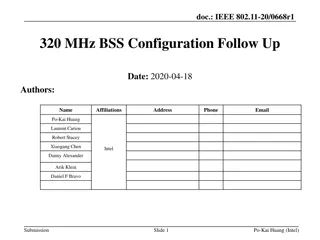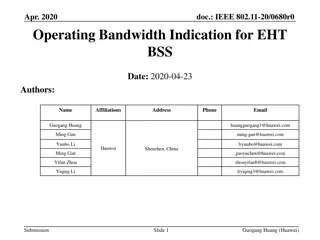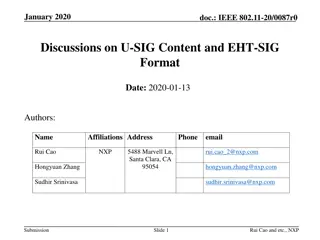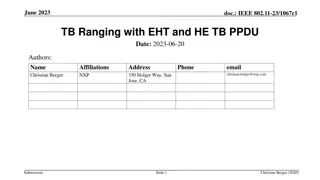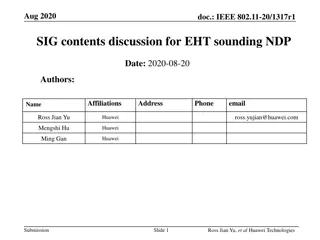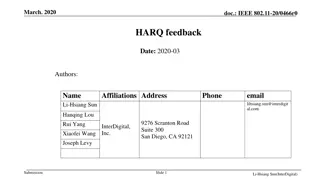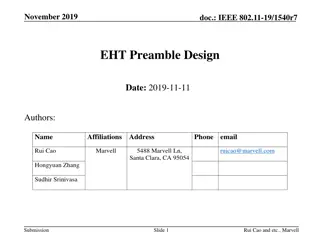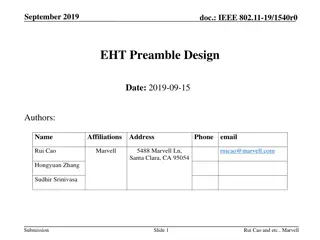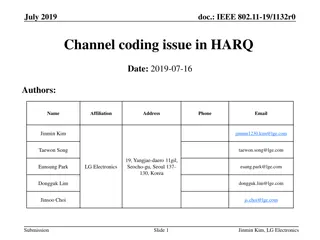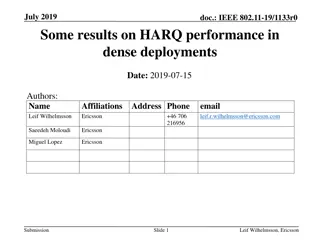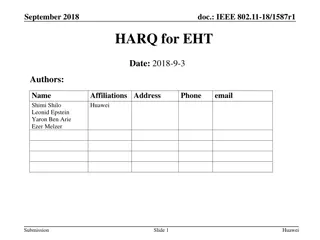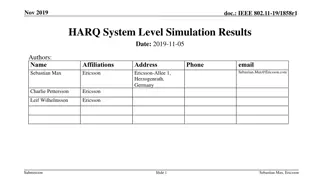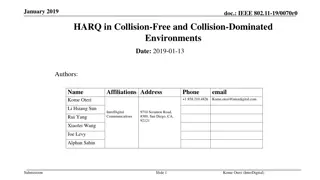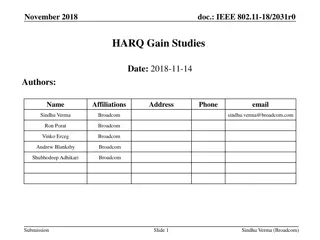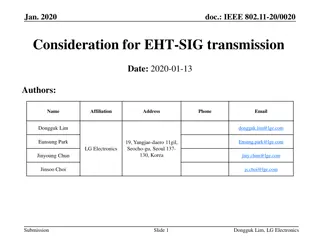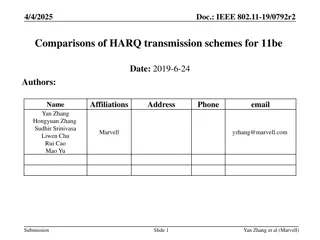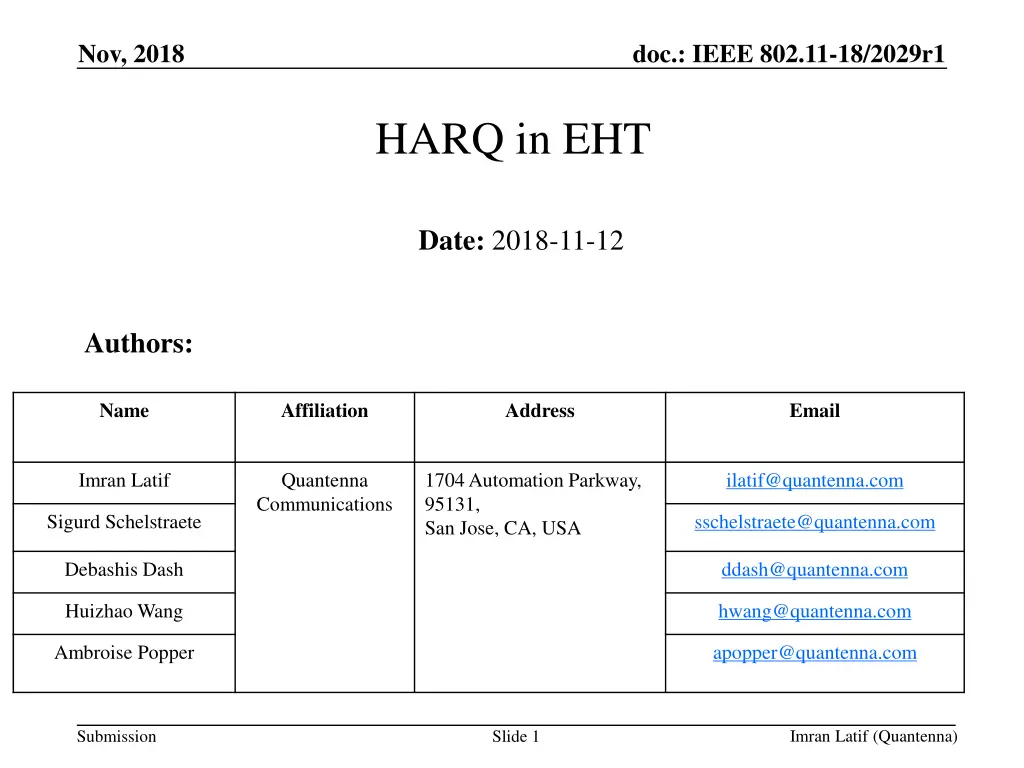
Understanding Hybrid-ARQ in Wireless Communications
Explore the application of Hybrid Automatic Repeat reQuest (HARQ) in Enhanced High Throughput (EHT) wireless systems, evaluating its performance through simulations and discussing key takeaways for implementing HARQ to enhance link efficiency and throughput in wireless networks.
Download Presentation

Please find below an Image/Link to download the presentation.
The content on the website is provided AS IS for your information and personal use only. It may not be sold, licensed, or shared on other websites without obtaining consent from the author. If you encounter any issues during the download, it is possible that the publisher has removed the file from their server.
You are allowed to download the files provided on this website for personal or commercial use, subject to the condition that they are used lawfully. All files are the property of their respective owners.
The content on the website is provided AS IS for your information and personal use only. It may not be sold, licensed, or shared on other websites without obtaining consent from the author.
E N D
Presentation Transcript
Nov, 2018 doc.: IEEE 802.11-18/2029r1 HARQ in EHT Date: 2018-11-12 Authors: Name Affiliation Address Email Imran Latif Quantenna Communications 1704 Automation Parkway, 95131, San Jose, CA, USA ilatif@quantenna.com Sigurd Schelstraete sschelstraete@quantenna.com Debashis Dash ddash@quantenna.com Huizhao Wang hwang@quantenna.com Ambroise Popper apopper@quantenna.com Imran Latif (Quantenna) Submission Slide 1
doc.: IEEE 802.11-18/2029r1 Background Hybrid-ARQ is a well-studied and widely used mechanism in wireless, especially cellular communications, to improve link efficiency For example, LTE, LTE-A, 5G and it has been part of in 802.16 HARQ presentations were made in previous meetings[1][2] EHT seems to have clear interest in exploring HARQ as a candidate technology We present some simple results of our investigation and way forward for HARQ in EHT Imran Latif (Quantenna) Submission
Nov, 2018 doc.: IEEE 802.11-18/2029r1 HARQ Simulation Parameters Pure PHY level simulation to observe the PHY gain No MAC level overhead considered MPDU = Codeword SISO simulations Only one retransmission Channel D Block channel (highly correlated channels between retransmissions) iid channel (even between retransmissions) Chase Combining (CC) HARQ (retransmission + combining of same packet) Simulated MCS 0 - 7 Throughput results (total number of bits/total time) Fair Link level performance evaluations Retransmissions consume resources so gains should reflect that, i.e., PER analysis is not fair Slide 3 Imran Latif (Quantenna) Submission
Nov, 2018 doc.: IEEE 802.11-18/2029r1 CC HARQ - Results High Complexity + High Storage Requirement Low Complexity + Low Storage Requirement Imran Latif (Quantenna) Submission Slide 4
Nov, 2018 doc.: IEEE 802.11-18/2029r1 HARQ take-away from Results In previous results 3-4dB of gain for CC was shown Our results verify that gain HARQ gain highly depends on channel variation (only frequency domain is considered here) Depending on correlation in channel, HARQ gain varies Since ARQ always happen, combining data on the receiver side does no harm (of course at the expense of increased computational complexity + storage) Higher MCS -> higher complexity + higher storage Higher throughput gains Lower MCS -> relatively lower complexity + lower storage Range extension Sweet spot to use HARQ at lower rates for purposes of range extension Imran Latif (Quantenna) Submission Slide 5
Nov, 2018 doc.: IEEE 802.11-18/2029r1 HARQ take-away from Results With Incremental Redundancy (IR) version of HARQ, expected gains can be higher than CC (IR is not simulated here) However, these type of throughput based results are not sufficient enough to evaluate the benefits of HARQ. Detailed analysis of various implementation aspects of HARQ for EHT is required. Imran Latif (Quantenna) Submission Slide 6
Nov, 2018 doc.: IEEE 802.11-18/2029r1 Implementation Aspects for HARQ in EHT MAC level protocol support for HARQ on top of ARQ and combining with the effects of rate adaptation HARQ based control information for each packet at PHY level HARQ-SIG DATA L-STF L-LTF L-SIG Legacy Preamble Simpler techniques of HARQ requiring less memory and low retransmission and acknowledgment overhead New feedback mechanism to support HARQ retransmissions feedback based on codeword and MPDU level Storage on Tx side for sending either the failed codewords or failed MPDUs in retransmissions Storage on Rx side to combine MPDUs and codewords until various (2-3) retransmissions CC Vs. IR-HARQ for LDPC Complexity Vs. Performance Imran Latif (Quantenna) Submission Slide 7
doc.: IEEE 802.11-18/2029r1 Summary We present our findings about implementation of simplest HARQ scheme and show the gains which are being presented and discussed. But does these gains fit EHT scope ? Range extension for low complexity Vs. Throughput gain for higher complexity It needs further analysis considering various implementation factors some of which we mentioned in this presentation. It is essential to discuss these implementation aspects (and other aspects which we did miss in this presentation) and include them in evaluation study. Imran Latif (Quantenna) Submission
Nov, 2018 doc.: IEEE 802.11-18/2029r1 Reference [1] Shimi Shilo HARQ for EHT (DCN:1587) 13 Sep 2018 [2] Ron Porat Multi-AP-HARQ-for-EHT (DCN: 1116) 6 July 2018 Imran Latif (Quantenna) Submission Slide 9
Nov, 2018 doc.: IEEE 802.11-18/2029r1 Backup Slides Imran Latif (Quantenna) Submission Slide 10
Nov, 2018 doc.: IEEE 802.11-18/2029r1 HARQ performance in Wi-Fi 3-4 dB gain was claimed for CC-HARQ lower MCS PER results shown here confirm this Results for channel D (iid realizations between retransmissions) are shown below using CC-HARQ PER results do not translate directly into performance gain when compared as effective throughput (total number of bits/total time) Imran Latif (Quantenna) Submission Slide 11
doc.: IEEE 802.11-18/2029r1 HARQ Performance Review Results for block channel between retransmissions Mostly range extension based on throughput Depending on correlation in channel, throughput even reduces Fair Link level performance evaluations Retransmissions consume resources so gains should reflect that, i.e., PER analysis is not fair Things to consider: Relatively small gains at high MCS in throughput curves Growing complexity to accommodate high rates with HARQ Sweet spot to use HARQ at lower rates for purposes of range extension Imran Latif (Quantenna) Submission


